Video
Learning Purpose
Welcome to my video guide on the 3D Time Series Visualization on 2D Map research project. As someone deeply entrenched in this research, I recognized the profound value it brings to the academic and practical realms, but I also understood that conveying this complicated concept is equally critical. Hence, this video was conceived with a distinct purpose in mind.
Our project purpose is to bring clarity to the global pandemic scenario by visually representing the spread of communicable diseases, such as COVID-19 cases. Using an innovative approach, we’ve developed a 3D time series representation overlaid on a 2D map. This visualization technique allows viewers to instantly grasp both the geographical spread and temporal progression of the virus. By transforming raw data into a visually intuitive format, I hope to offer policymakers, healthcare professionals, and the public a tool to better understand and respond to the evolving pandemic landscape.
The video started with sharing my own story – how I gained the opportunity to become the Research Assistant of Professor Junlin Ma and venture into this research. This part aims to inspire budding researchers about the avenues open to them to get the opportunity.
Our animation function is a marvel in itself, but for users to harness its full potential, they must understand each component. I provide a detailed breakdown of each argument of the animation function, ensuring that our audiences not only know ‘how’ to use it but also ‘why’ each component exists. A function is only as good as the data it processes. Thus, I also claimed the datasets required, ensuring users use the function most effectively.
Seeing is Believing, thus I showcased the research results, demonstrating the visual marvels achieved with our method. The tangible results of our hard work highlighted the function’s utility. This video aims to educate, by understanding our research and its practical application, viewers will recognize the vast benefits of our approach.
Applied Principles
So far, we delved deep into various principles that enhance the effectiveness of multimedia learning. In my video, I’ve consciously integrated several of the Cognitive Load Theory to optimize the learning experience. CLT was at the forefront of my design considerations. Considering our working memory has limitations, it’s crucial to present material in a manner that doesn’t overburden the learner.
Like my first blog, I first incorporated the redundancy principle, I ensured that information wasn’t presented in a redundant manner, thus avoiding unnecessary duplication which can confuse learners. I presented the research project in a very straightforward way. Besides, I also applied the signaling principle, Key information was pointed out effectively in my video, ensuring that learners could easily discern the core content. Voice and Image Principles are necessary. By using my own voice, I endeavored to establish a personal connection with the learners. The germane cognitive load is a challenge. I incorporated this principle by offering content that was challenging but understandable in my video, to keep a long-term retention of the content for learners.
I also incorporated storytelling techniques into my video. After seeing the inspiring TED presentations, I’ve consciously woven in several of these storytelling techniques to make my video resonate more deeply with the audience.
I applied the Tell a Personal Story to humanize the research, making it more accessible and emotionally resonant. Particularly, I told my audience I used to spend a week researching the wrong topic. For the Show. Don’t Tell technique, I recognized that the subject of 3D time series can be quite abstract, so I showed the research results directly to illustrate what is 3D time series. This helped to conquer the problem of overwhelming the audience with technical jargon. Lastly, by applying the End with a Positive Takeaway technique, I concluded the project presentation on a positive note emphasizing its potential benefits and implications for the future. This provided a concise and memorable summary that could spark further discussions and interest in the topic.
In conclusion, by incorporating these principles and techniques, I believe I’ve created a learning method that is both efficient and engaging, aligning well with the objectives of the teaching purpose.
Challenging
I had several challenges when I created the video for the 3D time series project. Video editing should be the biggest challenge for this time. Ensuring smooth transitions and a seamless narrative flow was a daunting task. Editing is time-consuming because achieving a professional look requires meticulous attention to detail. Meanwhile, keeping the video concise while ensuring all key points were covered was another hurdle.
Besides, my video content has high complexity, and the academic nature of the 3D time series data concept meant that the content could be dry and difficult for a general audience to grasp. Therefore, given the theoretical nature of the topic, it was challenging to design the video in a manner that would retain the audience’s interest, which required a lot of brainstorming and creativity.
In sum, while creating the video was a valuable experience, it required significant effort, time, and creativity to ensure that the video was both informative and engaging.
Easy Parts
The video creation for the 3D time series project besides being challenging in many aspects, also had its easy parts.
I had spent nearly four months on this research, I was deeply familiar with the subject matter. This made it much simpler to decide what information to include and how to present it in the video. Furthermore, I knew precisely what I wanted to convey. This clear understanding helped streamline the production process from scripting to final edits, reducing the time and effort spent on revisions.
Another part is deciding on the theme was straightforward. I’ve always been eager to introduce this research project to a wider audience. This assignment provided the perfect platform, aligning with my intrinsic motivation. At the same time, my genuine interest in the topic undoubtedly made the entire process more enjoyable. When I’m passionate about what I’m sharing, it makes tasks feel less like work and more like sharing a part of myself.
Impovement for Next Video
To approach video capturing differently next time, I will definitely practice more on video editing. Since video editing was my biggest challenge, I consider investing time in learning more about the tools and techniques.
Also, since the content was academic and potentially hard for some to grasp, I will show a draft to someone unfamiliar with the topic to get feedback. Their feedback can help make the video more accessible and engaging for a general audience. To combat the academic nature of the content, I consider making my videos with interesting pictures, funny outfits, or exaggerated body movements. These can impress the audience and make it easier to understand the content.
‘Practice Makes Perfect’ was embedded in my mind for a long time, but I didn’t spend too much time to practice on my speaking in this video. The more familiar I become with my content and equipment, the smoother the recording process will be. I will also try to focus on the most compelling aspects of my study, simplifying complex topics, and passionately conveying my findings.
By addressing the challenges and leveraging the easy parts, my next video project will not only be smoother but also more engaging for my audience.
Script and Storyboard
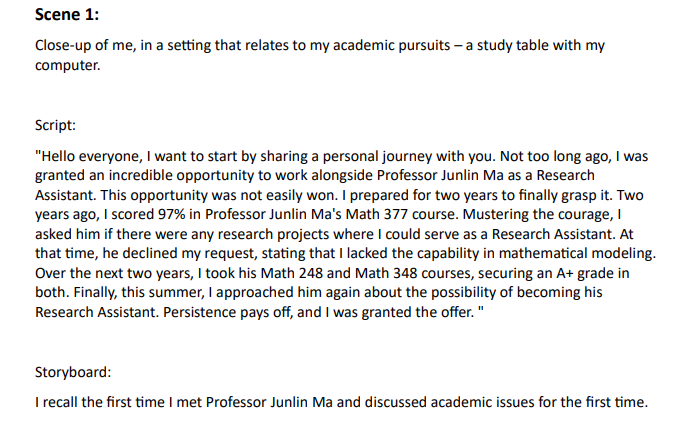
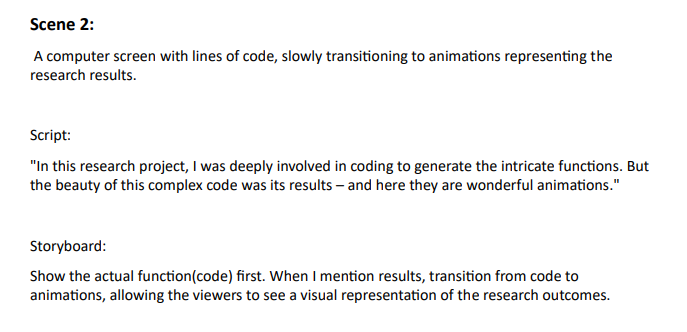
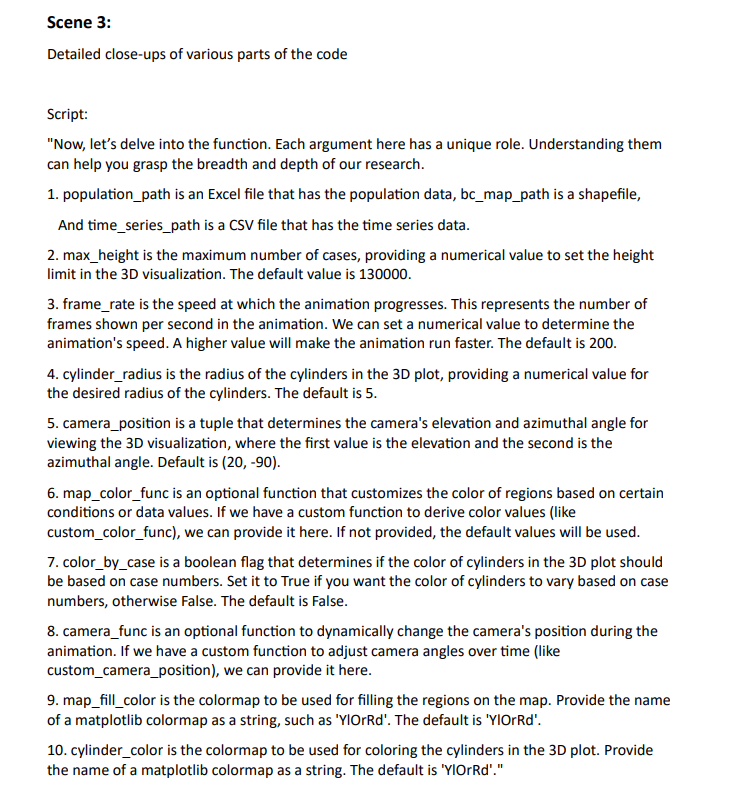
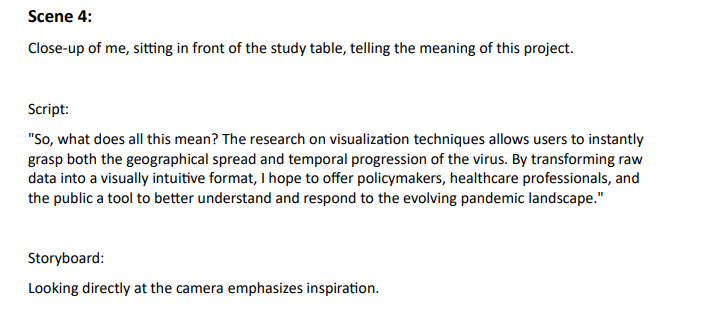
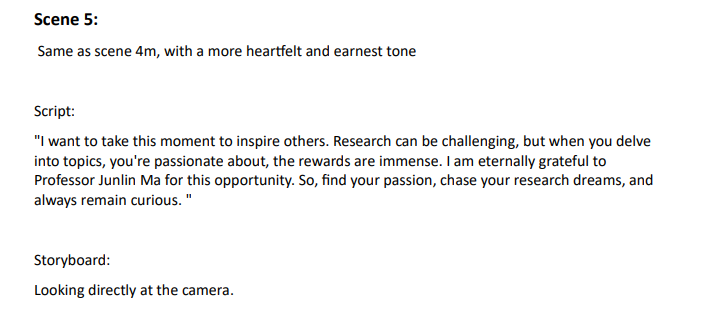
Leave a Reply
You must be logged in to post a comment.